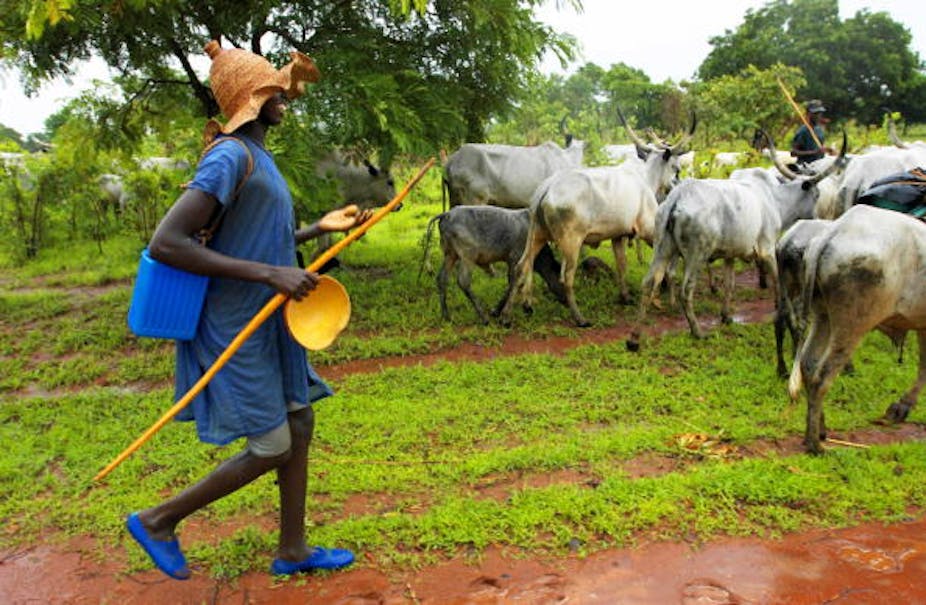Clashes between herders and local farmers in several communities in Nigeria have increased in recent years. One report put the number of deaths at more than 3,641 between 2016 and 2018. Over 1,300 deaths were recorded in the first half of 2018. Another report says about 62,000 people were displaced over the two years from 2015 to 2017.
The conflict is impacting the economy negatively. Nigeria loses almost US$14 billion in revenue annually as a result of the conflict. It is increasingly threatening the security, peace and development of the Nigerian state.
My PhD research cast some light on how conflict between farmers and herders arises in one particular context – an irrigation project in north-west Nigeria. My study centred on the productivity, food security and livelihoods of smallholder households in the project. What emerged was that a project like this provides resources to which farmers and herders don’t have equal access. This is a source of conflict.
I argue that there is no single path to a solution. But all those involved need to be heard.
Irrigation project case study
I explored the enablers and constraints to agricultural production among smallholder farmers using the Middle Rima Valley Irrigation Project as a case study. Located in Sokoto State, the project is an initiative of the Nigerian government and was established to provide irrigation facilities for all year round farming activities on an area covering about 5,360 hectares.
I embarked on the research to add to our understanding of the links between water scarcity, food production, food security and environmental sustainability. I obtained data from smallholder farmers and officials of the Sokoto Rima River Basin Development Authority managing the project. I interviewed these respondents to gain insights on the project’s performance and its effects on the livelihoods and food security of smallholder households.
In the process, I kept encountering the fact that farmer-herder conflict was becoming more common and was taking its toll on agricultural production in northern Nigeria.
Factors that drive conflict
The drivers of farmer-herder conflict reflect several underlying historical, political, economic and environmental contestations. Factors contributing to the conflict include climate change (reducing pasture and pushing migration), institutional failure and cultural differences.
Read more: Violence is endemic in north central Nigeria: what communities are doing to cope
Explanations often refer to the collapse of symbiotic relations between the parties. In the past, farmers and herders strengthened their relationship through reciprocal gestures and exchanges. This helped resolve disputes.
My research showed how the differences between herders’ and farmers’ productive systems led to a tussle over natural resources. In particular, the enclosure of lands either for grazing or for agriculture restricts the way both groups can make a living. On the one hand, farmers in the irrigation project consider herders as a group that damages crops and irrigation infrastructure such as canals. On the other hand, herders see the project as spaces of enclosure, restricting their access to natural resources and reshaping their livelihoods.
It is clear that the irrigation infrastructure and farmlands have emerged as spaces of contestation.
A combination of resource availability and scarcity drives the conflict. Water and land are available but preserved for farmers’ use. Pasture is unavailable for herders. So resources are not absolutely scarce but scarce in relation to the needs of a particular group.
Agricultural production takes priority at the expense of livestock production in Middle Rima Valley Irrigation Project, and herders who previously had access to pasture before the development of the irrigation facility are not adequately provided with alternatives.
Nigeria’s farmer-herder conflicts have brought about material losses, injury and death, and are likely to increase food insecurity and poverty. This was very much the case in the Middle Rima Valley Irrigation Project. There is overwhelming evidence of the reduction in agricultural output owing to incessant conflict. Farmers I interviewed spoke about how cattle raided the crops in their farms. An irrigation official said herders and their cattle veered off their grazing routes and encroached the irrigation project.
Way forward
The government’s initial proposal of cattle colonies (which are 30 to 40 times bigger than ranches) to solve the conflict has elicited public outcry about the plan’s practicability and implications.
Critics point out its potential to displace people and disrupt livelihoods. This would recreate the problem that contributes to conflict in the irrigation project. Instead, many have advocated for the ranching system, which would involve government helping individuals to acquire land for ranching. These two proposals tend towards settling herders who are historically pastoralists, and denying their right to self-determination.
I therefore recommend there should be more choices or approaches that consider the needs of both farmers and herders. While ranching could be done, grazing reserves or routes should be clearly demarcated, implemented and enforced for herders who don’t want to settle in one place on a ranch.
The National Livestock Transformation Plan, approved in 2019, is a more comprehensive proposal to address migratory or open grazing. The plan has suffered from implementation challenges which need to be sufficiently addressed.
At the local level, improving social relations between farmers and herders is important. Efforts should be geared towards fostering dialogue between the groups. Also critical is establishing local grassroot mediation forums or dispute resolution committees representing both groups, religious and traditional leaders, youth and women.
Finally, genuine and inclusive stakeholder engagement in the formulation and implementation of any proposal is important. This includes the determination and demarcation of grazing reserves. All parties concerned must sit down together and find workable solutions.

